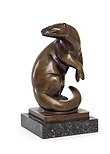Max Esser
Max Esser (born May 16, 1885 in Barth , † December 23, 1945 in Berlin ) was a German sculptor and medalist . He was best known as an animal sculptor and designer of porcelain figures.
Life
From 1900 to 1903 Max Esser attended the teaching institute of the Kunstgewerbemuseum Berlin and the Berlin Art Academy , where he studied with the animal sculptor August Gaul , whose son-in-law he later became. From 1906 Esser exhibited regularly at the great Berlin art exhibitions . From 1908 he worked in the Schwarzburg workshops for porcelain art in Unterweißbach . From 1920 he lived in Meißen , where he was employed by the Meißner Porzellanmanufaktur from 1920 to 1931 , and from 1924 as head of a master's atelier. He later made porcelain models for Hutschenreuther, the Königliche Porzellan-Manufaktur Berlin and Rosenthal .
On the world exhibition Paris in 1937 his 1934 resulting sculpture was otter with a Grand Prix award.
Max Esser died in Berlin in 1945 at the age of 60. He was buried in the Zehlendorf cemetery . The grave is preserved.
plant

- 1912: Fuchsbrunnen in the Cecilien Gardens in Berlin
- 1919: Mandarin duck , Meissen porcelain
- 1921: Tomb for his father-in-law August Gaul in the Dahlem cemetery in Berlin
- 1926: otter , Böttger stoneware
- 1926: Dschelada monkey in the Berlin zoo
- around 1928: beaver
- 1934: Otter , noble version in Meissen porcelain
- around 1934: The Battle of the Teutoburg Forest , chess game in silver and enamel
- 1935: Adler, Adlerhorst with clutch on the children's playground inside a block of residential buildings in Berlin-Haselhorst , Lüdenscheider Weg 4 52 ° 32 ′ 50.5 ″ N , 13 ° 14 ′ 6.6 ″ E
- around 1935: elephant , limestone
- 1936: Great Crested Grebe in the Berlin Zoological Garden , Hippopotamus House
- around 1937: Wild duck group
- 1938/1939: Motorcyclists at the former northern curve of the AVUS (erected in 1989)
Shown are Ewald Kluge on DKW (left) and Ernst Henne on BMW (right), the third figure - Heiner Fleischmann on NSU - was melted down during the Second World War.
- Motorcyclists
- 1939: King Pheasant in the Berlin Zoological Garden, Pheasantry
- undated: Bittern group , in the Berlin Zoological Garden, in the pond in the predator house
- 1949 (posthumously): Pegasus and billy goat for Rosenthal AG
His contributions to the interior design of the Expressionist Kreuzkirche in Berlin-Schmargendorf - including the altar and a five-meter high cross made of Meissen porcelain - were lost in a night of bombing during World War II.
In addition, some of his medals have come down to us.
literature
- Esser, Max . In: Ulrich Thieme (Hrsg.): General Lexicon of Fine Artists from Antiquity to the Present . Founded by Ulrich Thieme and Felix Becker . tape 11 : Erman-Fiorenzo . EA Seemann, Leipzig 1915, p. 46 ( Textarchiv - Internet Archive ).
- Esser, Max. In: Peter Bloch, Sibylle Einholz, Jutta von Simson (eds.): Ethos and Pathos. The Berlin School of Sculpture 1786–1914. Staatliche Museen Preussischer Kulturbesitz, Berlin 1990, p. 96 f.
- D. Zühlsdorff: Ceramic brand lexicon. P. 407.
- Karl H. Bröhan (Ed.): Porzellankunst II. Berlin 1969, p. 109.
- Heike Drummer: The "Fountain of German Crafts" [by Max Esser] - A contribution to the self-image of the city of Frankfurt am Main under National Socialism , in: Kritische reports 2 (1995), pp. 58–65.
Web links
Individual evidence
- ^ Hans-Jürgen Mende : Lexicon of Berlin burial places . Pharus-Plan, Berlin 2018, ISBN 978-3-86514-206-1 , p. 672.
- ^ Senate Department for Urban Development: Public fountains in Tempelhof-Schöneberg - Fuchsbrunnen
- ↑ Sculpture in Berlin: Max Esser - Adler ( Memento of the original of September 27, 2007 in the Internet Archive ) Info: The archive link has been inserted automatically and has not yet been checked. Please check the original and archive link according to the instructions and then remove this notice.
- ↑ Rosenthal Designer Portraits: Esser, Max ( Memento of the original from June 10, 2015 in the Internet Archive ) Info: The archive link was inserted automatically and has not yet been checked. Please check the original and archive link according to the instructions and then remove this notice. .
| personal data | |
|---|---|
| SURNAME | Esser, Max |
| BRIEF DESCRIPTION | German sculptor, medalist and porcelain maker |
| DATE OF BIRTH | May 16, 1885 |
| PLACE OF BIRTH | Barth |
| DATE OF DEATH | December 23, 1945 |
| Place of death | Berlin |




